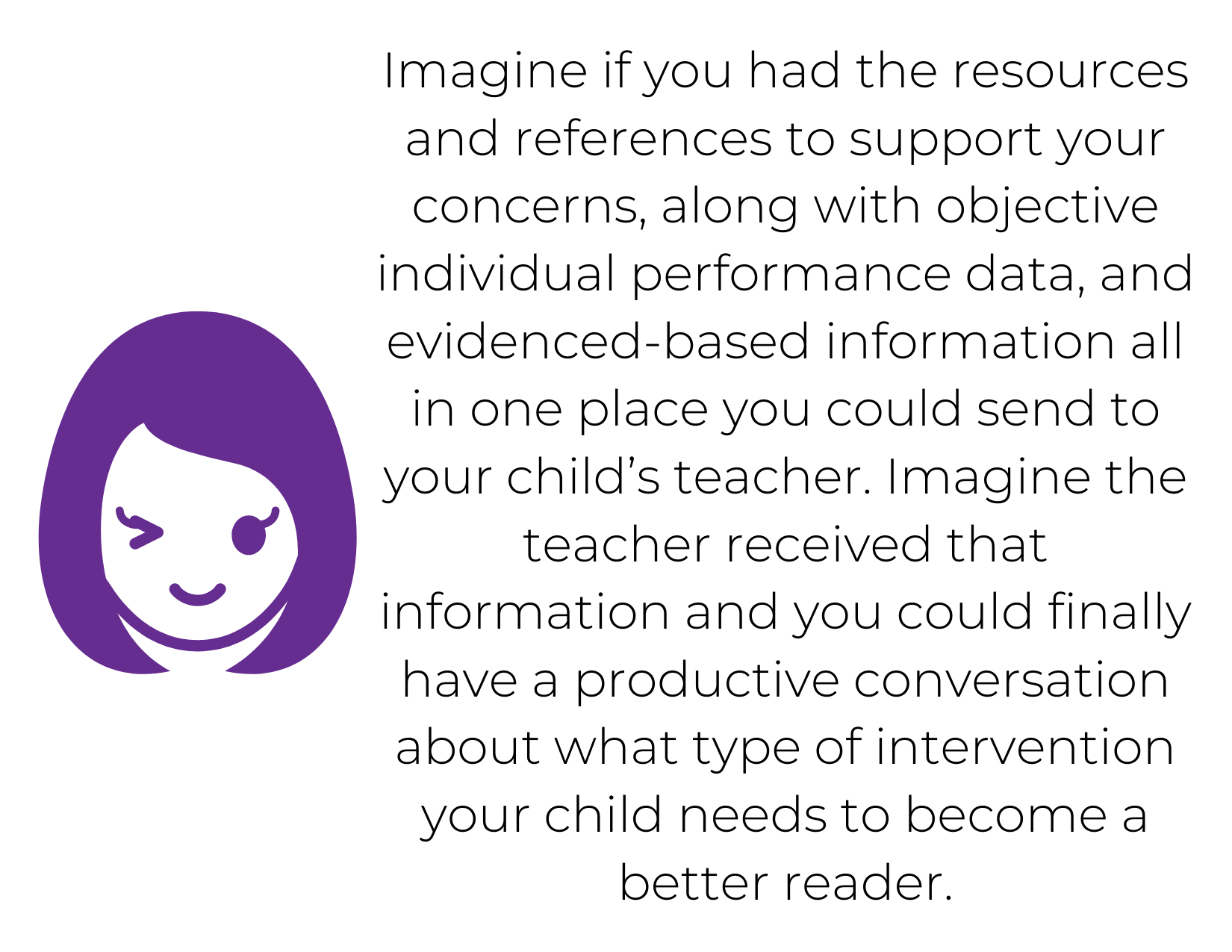Savvy Parent Dyslexia Screener
Get your child the reading support they need at school using data you collect at home!

What if the school responded to concerns about your child’s reading by implementing a proactive intervention approach instead of waiting for your child to fail and missing the critical window of early literacy intervention?
Get your child the reading support they need at school using data you collect at home!

You have a family history of dyslexia and are worried your child will struggle in school.
Your gut is telling you your child should be performing better at school in early literacy and reading activities but the teacher seems unconcerned.
You talked to the school and were told to just read to your child more or practice flash cards more.
Your child is having difficulty remembering the alphabet, letter names, making rhymes, or sounding out words.
Your child’s handwriting is extremely difficult to read.
Your child is having difficulty spelling their name correctly in Kindergarten or first grade.
Your child has an extremely hard time with sight words or “forgets” them the week after the test.

The Savvy Parent Dyslexia Screener is a step-by-step parent guide to collecting data at home that helps determine if your child is at risk for a literacy disorder.




Hi! My name is Michelle. I’m a speech-language pathologist, a professional member of the International Dyslexia Association, and am trained in multiple structured literacy approaches. I also have a daughter with dyslexia, so I’ve been on both sides of the IEP table. It’s very different as a parent. Our journey to getting appropriate services in place within the school system was stressful, emotional, and full of tears.
We had good teachers, but they were stuck in a system they didn’t have the power to change. I asked the questions- why isn’t the school doing more, how did they miss her, do I need to put her in private school? I looked into all the therapy options and the research supporting them. I took a deep dive into the world of dyslexia and was able to absorb information quickly because of my background in language development- but I’m going to tell you I didn’t learn about dyslexia in school. I learned the foundational skills to become a good language therapist, but as an SLP I misunderstood dyslexia too, until I had a personal need to learn about it. It breaks my heart now to think about the kids I missed earlier in my career simply because I didn’t know what I didn’t know. We are all on a journey to learn more; I tell Amelia the same thing. Part of her nightly prayer is to “learn something everyday”. I still have the same prayer for myself.
I know there are many professionals in the educational setting that truly want to help children do better; they are just misinformed on what the early signs of dyslexia are or what the law says about schools using the term dyslexia. This resource gives them the facts so they can begin making more informed decisions about how to help your child learn to read.
You get all this...
A digital workbook that includes 13 evidenced-based activities for your child to do with detailed written instructions on how to complete them.
A video example of me administering the activities to a child with dyslexia- complete with real life distractions due to attentional problems! (It’s my daughter and I definitely “mom stare” her a few times).
A downloadable child response form and parent record form to use while completing the activities.
The Literacy Disorder Risk Calculator, which clearly communicates your child’s risk factors for a learning disability and signs of an early literacy disorder, so they can implement an appropriate reading intervention strategy.
Bonus: 13 Research-based references supporting all the information in your letter.
Bonus: Detailed explanation of how each activity is related to literacy development and at what age/grade these skills should develop.
Bonus: A list of FREE resources the teacher/ school can use to do their own literacy screen and progress monitoring data that is in alignment with the science of reading.


No. This is an informal screener developed using evidenced-based information. It was designed to help parents work with the school so that appropriate reading interventions can be given during the critical time-frame of Kindergarten to First Grade.
The screener was developed to identify children in Kindergarten or First grade who would benefit from the Intervention through the schools- typically called Response to Intervention (RTI).
You can still give the assessment. If they are a struggling reader, they will still have difficulty. In the example video I give the screener to my daughter who’s in 3rd grade, and she still struggles with several of the activities because she’s dyslexic. A child who’s still struggling with these activities in second grade or above has even MORE reason to receive intervention from the school. All the activities in this screener should be mastered by the end of First grade.
That’s okay. I walk you through everything. I provide detailed explanations in both written form and on a video to show you exactly what to do.
All you have to do is complete the Literacy Disorder Risk form. You click the boxes that apply to his/ her performance, fill in your child’s personal information and send it to the teacher.
I wish I could, but that would be unrealistic. My goal is to give you the data and resources to be your child’s best advocate. The data you collect at home and the individualized letter with your child’s results should allow you to begin a productive conversation about what the next steps are at your child’s school.
If you have documented a legitimate concern and have valid evidence to support it, the school has a legal responsibility to provide Free and Appropriate Public Education for each child. They also have a legal obligation under the Child Find Statute to find all children with special needs regardless of whether or not they would qualify for an IEP. Dyslexia is the most common type of learning disability and if schools are not identifying at least 15% of their population with some degree of dyslexia they are under-identifying them.
They are misinformed. Unfortunately, many educational professionals are misinformed regarding their role in dyslexia in the school. I include a link to federal resources so you can help educate them.
You have access to the screener for the lifetime of the course and are guaranteed access for at least 3 years.
Here's how the Savvy Parent Dyslexia Screening Process works....
Step 1: Click the button to purchase your digital copy of the Savvy Parent Dyslexia Screener.
Step 2: You’ll be prompted to create an account to gain instant access to the course material.
Step 3: Print parent record form and child response form, watch the instructional video and complete the 13 activities listed.
Step 4: Complete the Literacy Disorder Risk Calculator (LDRC) and enter your child’s results and personal data.
Step 5: Send the completed LDRC and personalized letter to your child’s teacher to begin a productive conversation about your child’s reading performance and what the appropriate next steps are to support reading success.
Due to the digital and downloadable nature of this product, there will be no refunds after purchase.
Imagine what it will feel like one week from now when you have completed the Savvy Parent Dyslexia Screener, entered your child’s data into the Literacy Disorder Risk Calculator, sent it to the teacher, and you receive a response requesting a meeting. During the meeting you are confident in your request because you have specific references to support your concerns.
Keep imagining that while meeting with the school and reviewing your child's performance from the LDRC, the teacher agrees there is a need for intervention through RTI (response to intervention) program, and a plan is put into action! Your work as an advocate will be far from over but believe me, once appropriate interventions are in place, it’s like a huge weight has been lifted. Instead of feeling frustrated and alone, you are now in a partnership with the school to help your child become a successful reader.
Get your child the reading support they need at school using data you collect at home!
